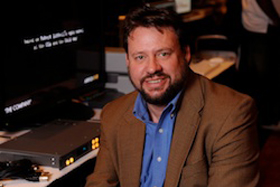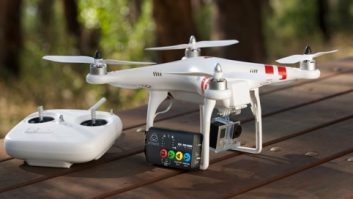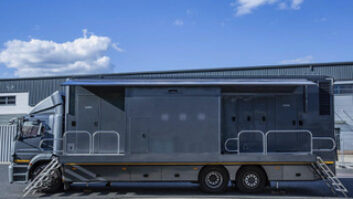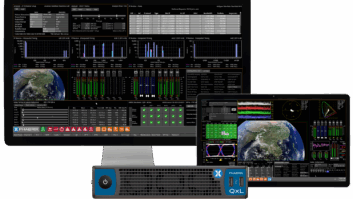
An increasing number of external recorders now handle 4K – indeed, some cameras can only record 4K if you use an add-on unit. However, not all recorders can handle the output of each camera equally well – sometimes due to the camera manufacturer’s reluctance to open its systems to third parties.
“4K recording is an interesting issue as there is currently relatively little in agreed upon format standards for delivery,” said Mitch Gross, Director of Communications, Convergent Design. “There are some cameras and there are some displays, and then there’s a whole lot of open space in between them. We believe that for 4K to become increasingly adopted this space must be filled with all sorts of hardware and software solutions.”
For Codex, “it’s really a case of which companies will allow partners to develop recording solutions (Arri, Canon) and which would rather keep recording proprietary (Sony). However, even for Sony, while we can’t make recorders that work with the F55 and F5, we do offer a workflow solution using Codex Vault to clone, archive, review and make deliverables from camera original data recorded to Sony’s media,” said Sarah Priestnall, Vice President/Market Development, Codex, whose Onboard S recorder can record 4K at up to 120fps with the Canon C500 camera. Sony has its own AXS-R5 Raw Recorder to record Raw 4K at up to 120 frames per second.
“Processing power, data storage and management and stream access,” are the main issues Suzette Ferguson, Cinedeck Senior VP of Worldwide Sales sees with 4K. “If a manufacturer chooses to restrict access to their image data stream, that makes working with their product difficult. Beyond that it really is a matter of horse power.”
“One aspect that is important to the external recorder market is that we could be looking at yet another frontier for the Format Wars of the past. If different manufacturers create competing flavours of 4K systems (as is already beginning to happen), an external recorder capable of capturing and/or outputting to these various flavours will become valuable. This is why we like to play nice with everybody,” added Gross.
According to Ferguson, 4K will simply continue the trend the industry has seen from standard definition to high definition, analogue to digital, and tape-based to file-based: “The exponential growth of recording standards and formats. Historically speaking, television producers were frustrated with the difference between PAL, NTSC and SECAM, but now we can only dream of those simple days. What you could pretty much count on the fingers of two hands 30 years ago have been replaced by an almost infinite number allowing the new millennium to really exemplify the age old comment: ‘Standards are great, everyone can have one’,” she said. So that users can achieve the desired results using the workflows they like, Cinedecks now have to deliver hundreds of commonly used combinations, with more being added on a regular basis. “There is no end in sight for this growth because there is effectively no ‘End of Life’ for a file and codec technology is constantly advancing,” she added.
The right workflow
Although there are difficulties in working with different 4K cameras, sometimes “the problem lies in workflow solutions,” according to Bryce Button (pictured), Product Marketing Manager, AJA Video Systems. Several AJA products are designed to address this, not just its Ki Pro Quad 10-bit 4:4:4 and 10-bit 4:2:2 4K/UHD/2K/HD recorder. Its Kona 3G card or its Mini-Converters, such as the Hi5-4K or 4K2HD, can also help with some of these problems. However, “on the recorder side, you need to be able to handle both Raw workflows and base band. The Ki Pro Quad provides this with debayering for the Canon C500 as well as baseband support for a camera like the Sony F55,” he said. It can accept Raw camera input via SDI and simultaneously output that data across Thunderbolt to attached DIT workstations, while debayering and encoding to Apple ProRes files on inserted AJA Pak Disks for ready-to-edit files.
“Right now [4K is] exploding with our customers in professional film and sports broadcast,” added Button. “Sports broadcast presents a huge opportunity for 4K—it’s an arena where fidelity of image is paramount to the viewer experience. In the case of broadcast at this moment in time, the abundance of 4K cameras on the market allows for a high resolution capture that hardware like our Corvid Ultra with TruZoom software can then exploit for 16×9 Region-of-Interest extraction for HD output; effectively allowing high resolution zooming within a 4K canvas for HD needs. This power is available in real time through a joystick controller as well as for file captured playback including keyframed zoom controls and speed manipulation.”
“4K generally means more data to move around, particularly if uncompressed,” said Priestnall. “Any 4K workflow must be able to clone and verify data as quickly as possible so that the original camera media can be recycled back to set. 4K playback and visual QC are also vital. Codex Vault enables the cloning and archiving of media from various cameras (such as Arri, Sony, Canon, RED) plus the creation of dailies. The Review module allows for playback and visual QC of material. This can be in an on-set or near-set environment or even in a remote location as Vault can run off a battery. Different cameras are being used on productions so Codex Vault provides a simple, unified workflow no matter what camera is used,” she claimed.
“4K means a LOT of data, perhaps far more than people realize,” added Gross. “It means an exponential growth in recording media, computing power, storage, and transfer & encoding times. People should begin to prepare for that as they enter into 4K production.”
He believes that there will be no single best workflow for 4K. “There will be many workflows. That is part of the new frontier of production. It started when we all migrated away from tape. Different ways of transporting and dealing with data files developed. The same will happen as people are confronted with the volume of material that 4K represents. For some it will mean more powerful machines. For others it will mean working with more heavily compressed file formats. For others still it will mean using smaller proxy files until they have to go back to the 4K material to finish a project. None of this is new, but people tend to forget that we had the same struggles just a few years ago when we were dealing with HD and less powerful computers,” said Gross.
The 4K future
“4K will have a huge impact on the external recorder market, and we’re already seeing that impact with the popularity of our Ki Pro Quad recorder. People want to invest in technology that will work for them today, but also meet their needs in the future,” said Button.
“4K is the new fad and it has much stronger legs than 3D ever did because it is simply an accessible, better-quality image than HD or 2K. Traditionally, the highest quality productions used 35mm and 70mm and that content remains marketable. Any of today’s productions interested in that kind of longevity want to create in 4K and all recorders will offer a way to get there,” said Ferguson.
External recorders are necessary because “Raw recording is available on very few cameras, as is 4K capture,” added Gross. “We also add an interface with our touchscreen panel that fundamentally changes the way one interacts with the cameras themselves. We like to think that we deliver a more complete integrated camera solution.”
Atomos is probably the main manufacturer of external recorders, with more than 30,000 units sold, but its CEO, Jeromy Young Young believes it is too early yet for a mainstream 4K recorder. While he agrees that 4K, Raw and 120fps HD are the next big developments, he predicts that this will be over HDMI initially “as 3G SDI doesn’t cut it and 6G is too slow for the real deal, only doing 4:2:2 4K at 24p and QHD up to 30p. 4:4:4 60p 4K can not be done until 12G is a reality, which is probably IBC next year for products,” he said.
“We will make the 4K unit available when there are more cameras and that is probably the end of 2014 depending on take up,” he added.
Parts of this article will appear in a feature on external recorders in the December issue of TVBEurope.
By David Fox
www.aja.com
www.atomos.com
www.cinedeck.com
www.codexdigital.com
www.convergent-design.com







